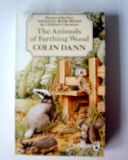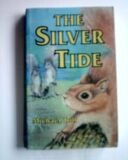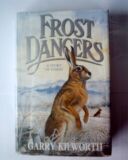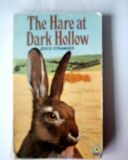
People say that life is the thing, but I prefer reading.
(Logan Pearsall Smith, Afterthoughts: "Myself")
In spite of this page's title, a wide variety of furry stories are covered here (or will be when the page is finished, at any rate), the only real criterion being that I've read them. (This accounts for the absence of obvious titles such as the Redwall series - I'll read one eventually, honest!) However, I do make sure that any contribution by rabbits (or hares, or even pikas in the unlikely event that I find a story with them in) is mentioned clearly. Unless otherwise stated, publishers' names and dates refer to the original British editions.
Ahem. Well, I couldn't really leave it out, could I? Amazingly enough, it has quite a lot of rabbits in! =:)
Not a patch on the original, and with too many "continuity errors" for comfort. A good example is the whole concept of a "secret river" in Efrafa. In Watership Down itself, Hyzenthlay tells Bigwig that she doesn't know what a river is - so how on earth can she have used the word in Efrafa? The single most annoying change, though, is allowing rabbits to laugh, which is clearly conveyed as unnatural in WD - Hazel and Blackberry have no idea what's happening when Cowslip laughs.
The book is split into three sections. First, there are some further tales of El-ahrairah, which are frankly rather lacklustre; he seems to have lost much of the scheming nature that made stories such as The King's Lettuce so much fun in the original book. This section also contains a couple of other rabbit stories, of which the most fun is the nonsense tale Speedwell's Story. Secondly, there are four accounts of events on El-ahrairah and Rabscuttle's journey home from their visit to the Black Rabbit of Inlé. Again, they're a bit flat. The final part of the book is what everyone was waiting for: what happened to Watership in the months after the victory over Woundwort. This bit has its moments - the treatment of the obsessive doe Flyairth, for example - but at under 100 pages it's just too short for any proper sense of narrative to build up. If this had been the book that had been published in 1972, I suspect Richard Adams' name would now be lost in obscurity.

Most people will probably know this story through the European animated series that came out a decade or so ago, but in fact it's been around for a good while longer than that. The plot is simple: a group of animals in the eponymous Farthing Wood, realising that their habitat is on the point of final destruction by humans, resolve to make the perilous journey to White Deer Park, a distant Nature Reserve that has already been visited by one of their number, Toad. The animals swear an Oath of mutual protection, allowing predators to travel with prey.
Apart from the Oath, the animals generally behave in a naturalistic fashion, except that as well as having the power of speech (and song), they also make use of human facial gestures such as grinning and crying. There's also a very touching love story between two major characters (not rabbits). One irritation is that the rabbits in the book are a world away from Hazel's heroes: they're generally a cowardly, superficial bunch and get the party into serious trouble more than once. There are also hares, who treat the rabbits as rather backward cousins.
Despite the somewhat negative portrayal of rabbits, this book is still highly recommended. For one thing, Colin Dann has, like Richard Adams, understood the importance of humour, and there are some very funny passages in the novel. It also doesn't shrink back from the darker side of life, and while there is much less explicit violence than in Watership Down, there are one or two moments which pack a real punch. If you can find one, go for a pre-TV series edition with the excellent cover illustration by Gillian Platt.
One of this book's claims to fame (apart from being the only furry novel I know of to focus on badgers) is that it is one of the few self-published novels to have been picked up by a major publisher (Penguin). The other thing that a lot of people notice is the complete absence of direct speech - it's all in a "Buckwheat asked the audience..." reported style, which some people like, but I found intensely irritating. If these animals can talk, then why not allow them to do so directly, without Mr Clement having to act as a "go-between"?
These badgers - who are in the "our home's doomed; we'd better find a new one" tradition of Watership Down itself - have much more in the way of formal ceremonial than the rabbits of WD, and have developed a more complex religion, although the way in which some of their terms (eg Elysia) are taken directly from human mythology is something I found rather intrusive. I'm also not sure whether I like the many "newspaper columns" that convey the badgers' progress to the human world. It's an idea used in The Plague Dogs, but in that book there's a lot more time spent in the human world, so it works better. Rabbits only appear incidentally in this book.

This is the first of the Dorset Squirrels trilogy, the sequels being The Second Wave and The Golden Flight. The book is set in the early 1960s, as Woburn's Grey Squirrels (the "Silver Tide" of the title) encroach on the native Reds' base on Dorset's Isle of Purbeck. The Greys know about such things as numbers (which play a vital role all through the book), and so find it easy to elbow out the "uncultured" Reds - how can they survive?
Although rabbits don't feature in the book beyond the odd sentence, there's clearly a heavy influence from Watership Down here, not least in the names used for some of the squirrels. What is different is the much greater amount of time spent in the human world, enough for us to get to know the character of the warden Tom, for example. Personally I don't care for too much of this sort of thing (Dea ex Machina is probably my least favourite chapter in WD itself), but it's not too intrusive here.
There are two particularly interesting aspects of the squirrel culture: firstly, the "Tags", which are epithets bestowed on animals for some particular reason - so that we have such as Chestnut "The Doubter" and Clover "The Carer". These don't have to be neutral: a squirrel who has in some way transgressed can be given a "down-tag", or someone who has done well an "up-tag". Secondly, there are the Kernels of Truth, which are rendered into English as haiku. These are the main repositories of squirrel lore. An example:
All passing strangers
Must be accommodated
At whatever cost.
This certainly isn't a "fluffy" tale - one particular sequence involving Bluebell is eye-openingly shocking. I was interested to see that, despite being produced on a shoestring by a tiny publisher, the trilogy is still in print, and available from amazon.co.uk.

This book is about hares, for the most part anyway, although rabbits get a reasonable showing. Having said that, the hare attitude to rabbits does contain a marked superiority complex that can be very irritating to rabbity types! The star of the show is a Highland hare named Skelter. It's a good life... until he's trapped by hare coursers. It's mostly a good, fun romp, but there's one plotline in particular that is deeply moving. Thanks to Hawthorn for reminding me of this one!
NB: I've recently seen this book on sale second-hand at amazon.com for $120, which works out at about £75! That's probably the worst overvaluation I've ever seen - you can get hold of it for a tenner.

Another hare book, this is so naturalistic that it's really pushing it a bit to call it furry. It follows the life of a jack named Rik from his earliest days, as he learns to survive in the wild, and has to contend with the steady destruction of his habitat. No speech involved here, but Stranger's style is one I just fell in love with - compound words such as "fox-fear-flash", for example.
Copyright © David "Loganberry" Buttery 2003-4. Updated 06/05/04.